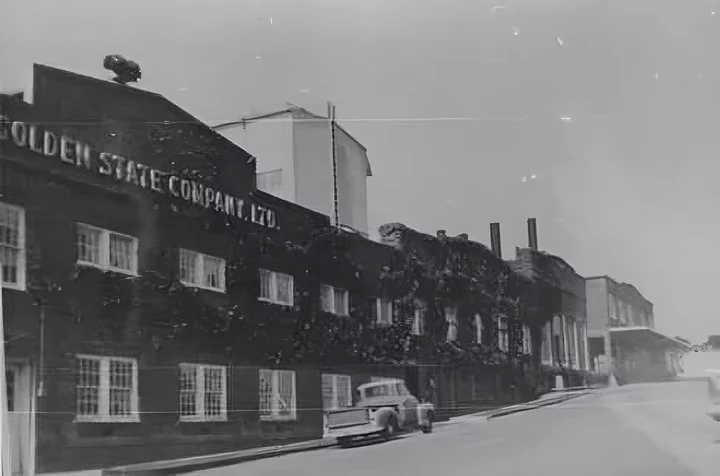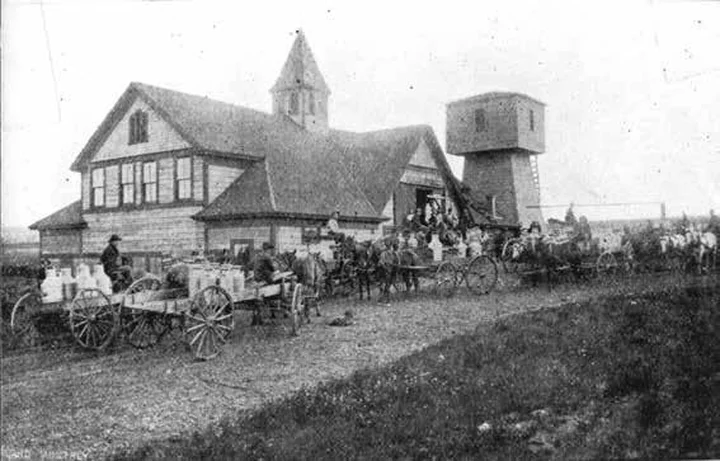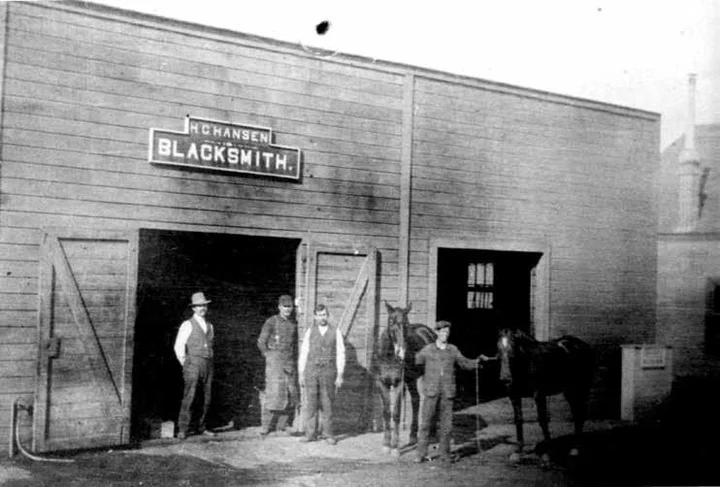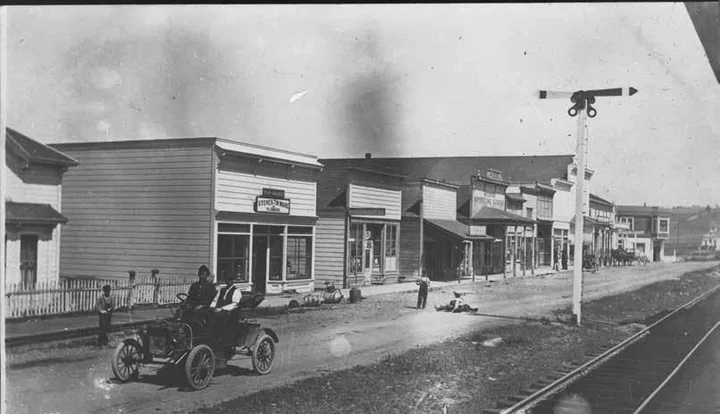Sunset Creamery, built in 1900. Location 1/2 mile northwest of Loleta. Photos via the Humboldt Historian.
I have been asked to tell you what I remember about
Loleta, or “Swauger” as it was originally called, but
was renamed Loleta about the turn of the century,
upon the suggestion of Mrs. Rufus (Martha) Herrick.
I came to this country from Denmark sixty-eight years ago, when I was seventeen. A group of us, numbering eighteen in all, left Denmark on May 8th, and arrived at Port Kenyon by boat, the Argo, on May 30, 1894.
Many of the persons in our group were relations of Peter Frey, so most of them stayed at his home. Mr. Frey had the Crown Creamery and a ranch rented from Mr. Nix Nisson. The rest of us were lodged in other Danish homes. “Happy” John Christensen, who is Orlan Christensen’s father, and I spent our first night in Humboldt County with the parents of Jimmy Jensen of Loleta, Mr. and Mrs. Svend Jensen. At that time, they lived across the Eel River from Singley’s Crossing, close to what is now Fernbridge.
The next day, they took me over to Swauger, where I started my first job in America working for Mr. Nis Petersen on his 370-acre ranch. This is the same ranch now owned by Orlan Christensen in Loleta and whose home is built exactly across the road from where the old Sunset Creamery was once located. The roads that now cross at that corner are called the Copenhagen Road and the Hawk Hill Road. At that time, it was called the Table Bluff road to Eureka, the only one at that time.
This ranch of Mr. Nis Petersen’s was rented from a Mr. Bagley of Springville, now Fortuna. The barn on this ranch, built in 1893, cost $1,000, and was built by a Swede named Holmberg. Lumber at that time was priced at $2.00 per thousand board feet. There was room for 100 cows and 10 horses in the barn. At that time, there were no dikes on the marsh lands west of Swauger, so when there was an unusually high tide, the salt water would come as far up the gulch as behind the hill, on which stood the one-room schoolhouse. This was on the northwest side of Loleta, where the West Wind Trailer Court is now.
As Mr. Petersen’s ranch had 200 acres of marsh land, he had the tide waters to fight. So, in many of his fields on the marsh, he had plowed his land up into ridges twelve feet wide the length of the field. In this way, the land became high enough to be above the ordinary tides, so it would give the marsh grass a chance to grow and provide feed for his cows and at the same time give the cattle a place to keep dry.
At the end of one of these fields was a big slough where, on a windy day, the water would be blown into waves two feet high. It looked so rough it was almost enough to make me seasick to watch it.
The land on the other side of this slough belonged to Cornelius Rasmussen, who had the Quill place rented. All the land west of us belonged to Rufus Herrick. I worked for Nis Petersen for two years. But it was four years before I had a chance to see Eureka. In 1905 or 1906, Mr. Petersen bought the ranch from Bagley for $35,000 or $36,000. The ranch was diked by this time.
In the late 1890s, Mr. Rufus Herrick owned 1,800 to 2,000 acres of marsh land. He was the only man with enough foresight to see the future value of that land. Mr. Herrick’s neighbors, Patrick Quinn and Hank Knight, only wanted a small amount of that type of land. They each homesteaded only eighty acres, but Mr. Herrick homesteaded close to 2,000 acres. Now, the government would pay a certain amount per rod [16.5 feet] for land reclaimed from the marsh. So, Mr. Herrick, Mr. Quinn, and Mr. Knight hired a Norwegian named Felton Dahle to supervise the building of dikes for them. Dahle hired a crew of Scandinavians who did the job by hand with shovels, spades and wheelbarrows. These dikes were only six to twelve inches, and all tides would go over them.
The card to which this picture was attached had the following caption typed on it: “Loleta’s foremost milk processing plant from 1892 until the present.” Golden State Creamery Co.
But as they actually were dikes, the government paid the landowners for reclaiming the land. This made it possible for Mr. Herrick to have his dikes built higher so that only the highest tides would flood his land. Marsh grass then started growing, and soon there was feed enough so cattle could be pastured at 50¢ per head per month for all that came back alive. Sometimes remains of cattle and horses would be found in the blind sloughs that ran in every direction on the marsh. The animals had died of starvation or had drowned as the tides came in.
An Italian named Serafini rented a few acres of marshland from Mr. Herrick. Both these men kept a few milk cows, and I remember seeing them come to the road with two small cans of milk in the back of their buggy on their way to the Diamond Spring Creamery at Swauger. At times, they hauled it back home again as the creamery had rejected it as being unfit for their use. The milk was bitter because the cows had been eating a yellow weed that grew on the marsh. As a result, Mr. Herrick found it difficult to meet his expenses, so occasionally he would sell some of his land to help pay taxes and the cost of diking. I’m not absolutely certain, but I believe it was at this time that Teichgraber brothers bought sixty acres, Mr. Waldner forty acres. Mr. Petersen paid $25 per acre.
There were many Danes who wanted to rent marshland from Mr. Herrick. Mr. Andrew Petersen rented 300 acres for $3.00 per acre per year for fifteen years; Cornelius Lorense and John Christensen 160 acres for $2.00 per acre per year for 10 years; Niels Schmith and John Holst 160 acres for $2.00 per acre per year for 10 years; and Erik Ericksen 160 acres for $1.50 per acre per year for 10 years. There were so many Danes who settled in this particular area that it was soon named “Copenhagen,” and the road that served it was called “Copenhagen Road.”
Diamond Springs Creamery in Swauger (Loleta) before it burned down.
All the Danes went into the dairying business, resulting in a great increase in milk deliveries to the Diamond Spring Creamery at Swauger. At the time, it was a co-operative creamery owned by several dairymen, who were: Mr. Foss; Mr. Charlie Dickson; Mr. Elliot, father of Wilsey Elliot; Mr. Perrott, grandfather of Henry Perrott; and perhaps a few others. They finally sold their shares in the creamery to the Gold Brook Creamery, which later sold to Smith & Co. They in turn sold to Libby, McNiel & Libby, who sold out to Golden State Creamery, which is now one of the last two remaining creameries in Humboldt County [as of 1964, when this was written].
As the population in Loleta got bigger, the people of the town started to complain about the smell from the hogging, which gave Mr. Foss a chance to offer his eighty acres on the marsh to his creamery for $25 per acre and in addition furnished them a strip of land twenty feet wide for road purposes and a pipeline right-of-way to pump the milk through one and one half to two miles long. Now they had to have somebody to attend to the hogs, so a man by the name of Jake Petersen offered to build them a house free of charge, but for them to furnish the material, if they would give him a job; so they did. That house is there yet and cost $100. It is 24 × 26 feet and 6 feet from the ground; having withstood many floods, storms and the big earthquake of 1906. The owners of the ranch are now Mr. and Mrs. Langhen, who bought from John Helt August 1, 1961. I sold the ranch to John Helt November 1, 1920. My first three children were born in that $100 house.
It was about 1899, when Swauger had been renamed Loleta, that three brothers came to that town. They were the Mitchell brothers. One was a schoolteacher who taught in the small school in Loleta, the second started a blacksmith shop where the Loleta Hotel now is, and the third went to Eureka to live and attend high school there.
H. C. Hansen Blacksmith.
This third brother was Clyde Mitchell, well-known by all creamerymen and dairymen. The second Mitchell brother, who was the blacksmith, later sold his location to a man named Hans Clausen, who built the hotel there. The blacksmith shop was moved down to the southwest corner of Montgomery and Market Streets where it later became the property of Chris Hansen, who operated it for many years.
Alongside Mr. Hansen’s blacksmith shop, a Mr. Sowash built a harness shop. Mr. Sowash was also a judge for several years. Halley Brothers built a store on Montgomery Street next to Sowash and rented it to a Martin Ericksen. Mr. Frank Bertsch put in 3 or 4 cabins alongside Ericksen’s store. On this same street, was Sam Merritt’s house, Holt blacksmith shop and house, and what you might call Van Duzen’s covered parking lot for horses and buggies of customers doing business in their store on the northeast corner of Montgomery and Market. On Market next to Van Duzen’s store was Mrs. Van Duzen’s home. Next, on the corner of Market and Main was Finney’s or Finney’s Saloon. If you followed Market Street up over and across the railroad track, you would find the Diamond Spring Creamery on your left. Back down on Main Street and directly across from the railroad tracks and depot, was the store of Dickson & Dickson.
Dickson & Dickson, in the picture, was built in 1893, before Bank of Loleta built circa 1910.
The Community Church in Swauger had been started and erected under the supervision of a Rev. Jasper, who came to the town in 1895. He also started a small newspaper here, which he later moved to Fortuna and published under the name of the Humboldt Beacon. Mr. Jasper also built a church over on the Island, along by the Excelsior Creamery, which was built in the same style as the Diamond Spring Creamery, near Peter Nissen’s corner—but neither the church nor the creamery is there anymore.
There is just this one last incident in Loleta’s early history that I want to tell you about. It proved the risk of selling real estate in those days in that part of our county. Mr. Herrick had a wealthy prospective buyer coming from back east to buy his entire ranch. So, Mr. Herrick asked permission of Mr. Nis Petersen to use the part of the road (now Copenhagen Road) that ran through his ranch.
Originally, this road had been graded to become a railroad bed for some railroad company which was going to run the track around Table Bluff. But the Vance Company, which built their railroad to Eureka through Table Bluff, probably bought the other company out and the land reverted to its original owners. So, these owners fenced off the old railroad right-of-way, and it was this road Mr. Herrick wished to use when his prospective buyer arrived. He could have taken the buyer up over the Bluff and then down to his ranch but, up from the top of the hill, the ranch looked like it was half-submerged and cut up in small sections. This was the impression Mr. Herrick wanted to save the buyer from by going across the lower road.
Everything went well and Mr. Herrick was talking and stressing all the good points of the ranch to the wealthy buyer when, all of a sudden, the Easterner disappeared into a blind slough! Needless to say, that ended the sale, and the buyer took the next boat back home.
###
The author, born Jorgen Matthiesen in Denmark, wrote this article in 1962. He passed away three years later at the age of eighty-eight and was buried in the Table Bluff Cemetery alongside his wife, Olga, who died in 1935 and his son, Jakob, who died in 1978.
###
The story above is excerpted from the Spring 2024 issue of the Humboldt Historian, a journal of the Humboldt County Historical Society, which itself had reprinted it from a 1962 issue of the Society’s newsletter. It is reprinted here with permission. The Humboldt County Historical Society is a nonprofit organization devoted to archiving, preserving and sharing Humboldt County’s rich history. You can become a member and receive a year’s worth of new issues of The Humboldt Historian at this link.





CLICK TO MANAGE